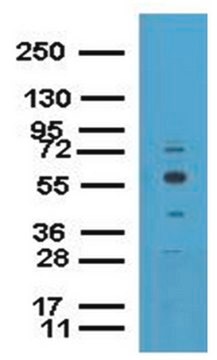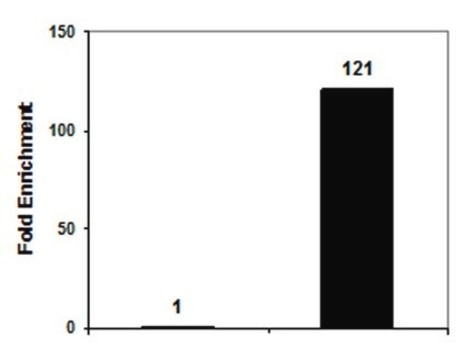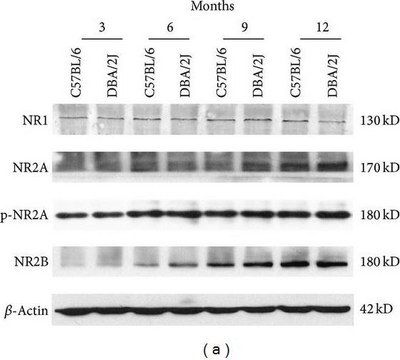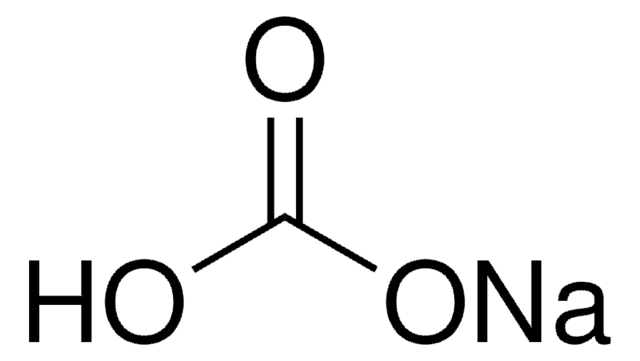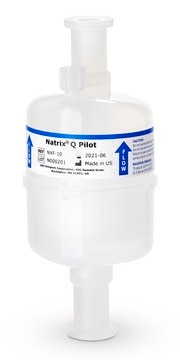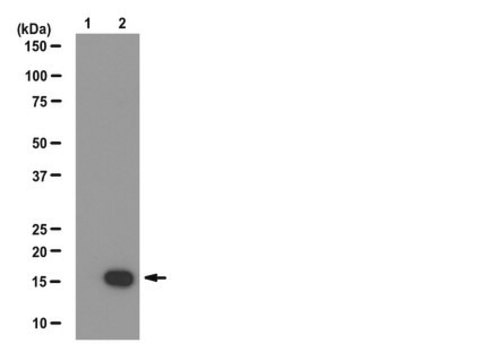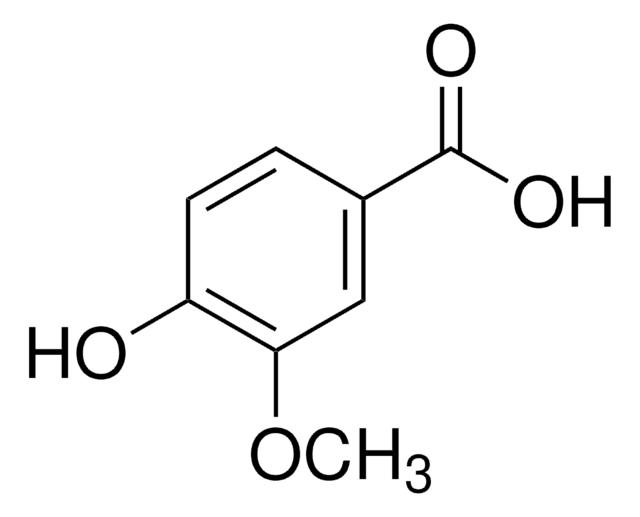17-685
ChIPAb+ Phospho-Histone H3 (Ser10) - ChIP Validated Antibody and Primer Set
clone CMA312, from mouse, purified by using protein G
Synonym(s):
H3S10P, Histone H3 (phospho S10), H3 histone, family 3A
Sign Into View Organizational & Contract Pricing
All Photos(3)
About This Item
UNSPSC Code:
12352203
eCl@ss:
32160702
NACRES:
NA.32
Recommended Products
General description
All ChIPAb+ antibodies are individually validated for chromatin precipitation, every lot, every time. Each ChIPAb+ antibody set includes control primers (tested every lot by qPCR) to biologically validate your IP results in a locus-specific context. The qPCR protocol and primer sequences are provided, allowing researchers to validate ChIP protocols when using our antibody in their chromatin context. Each set also includes a negative control antibody to ensure specificity of the ChIP reaction.
The ChIPAb+ Phospho-Histone H3 (Ser10) set includes the Anti-phospho-Histone H3 (Ser10) antibody, a negative control antibody (purified Mouse IgG), and qPCR primers which amplify a 166 bp region within the promoter of the human GAPDH gene. The phospho-histone H3 (Ser10) and negative control antibodies are supplied in a scalable "per ChIP" reaction size and can be used to functionally validate the precipitation of phospho-histone H3 (Ser10) associated chromatin.
The ChIPAb+ Phospho-Histone H3 (Ser10) set includes the Anti-phospho-Histone H3 (Ser10) antibody, a negative control antibody (purified Mouse IgG), and qPCR primers which amplify a 166 bp region within the promoter of the human GAPDH gene. The phospho-histone H3 (Ser10) and negative control antibodies are supplied in a scalable "per ChIP" reaction size and can be used to functionally validate the precipitation of phospho-histone H3 (Ser10) associated chromatin.
Specificity
Recognizes histone H3, Mr 17 kDa, phosphorylated at Ser10.
The immunogen sequence is identical in a wide range of animal and plant species, so broad cross-reactivity is expected.
Immunogen
Epitope: a.a. 1-19
Immunogen was a synthetic peptide corresponding to amino acids 1-19 of histone H3, phosphorylated at Ser10.
Application
Chromatin Immunoprecipitation:
Sonicated chromatin prepared from untreated or colcemid-treated HeLa cells (2 X 106 cell equivalents per IP) was subjected to chromatin immunoprecipitation using 2 μg of either a normal mouse IgG or Anti-phospho-Histone H3 (Ser10) antibody and the Magna ChIP G Kit (Cat. # 17-611). Successful immunoprecipitation of phospho-histone H3 (Ser10)-associated DNA fragments was verified by qPCR using Control Primers for untreated and treated chromatin samples (Please see figures). Data is presented as percent input of each IP sample relative to input chromatin for each amplicon and ChIP sample as indicated.
Please refer to the EZ-Magna G ChIP (Cat. # 17-409) or EZ-ChIP (Cat. # 17-371) protocol for experimental details.
Western Blot Analysis:
Recombinant Histone H3 or acid extracts from colcemid-treated HeLa cells (1 μg) were resolved by electrophoresis, transferred to PVDF membrane and probed with 1 μg/mL anti-phospho Histone H3 (Ser10), clone CMA312. Proteins were visualized using goat anti-mouse secondary antibody conjugated to HRP and a chemiluminescence detection system (Please see figures).
Sonicated chromatin prepared from untreated or colcemid-treated HeLa cells (2 X 106 cell equivalents per IP) was subjected to chromatin immunoprecipitation using 2 μg of either a normal mouse IgG or Anti-phospho-Histone H3 (Ser10) antibody and the Magna ChIP G Kit (Cat. # 17-611). Successful immunoprecipitation of phospho-histone H3 (Ser10)-associated DNA fragments was verified by qPCR using Control Primers for untreated and treated chromatin samples (Please see figures). Data is presented as percent input of each IP sample relative to input chromatin for each amplicon and ChIP sample as indicated.
Please refer to the EZ-Magna G ChIP (Cat. # 17-409) or EZ-ChIP (Cat. # 17-371) protocol for experimental details.
Western Blot Analysis:
Recombinant Histone H3 or acid extracts from colcemid-treated HeLa cells (1 μg) were resolved by electrophoresis, transferred to PVDF membrane and probed with 1 μg/mL anti-phospho Histone H3 (Ser10), clone CMA312. Proteins were visualized using goat anti-mouse secondary antibody conjugated to HRP and a chemiluminescence detection system (Please see figures).
Research Category
Epigenetics & Nuclear Function
Epigenetics & Nuclear Function
Research Sub Category
Chromatin Biology
Histones
Chromatin Biology
Histones
This ChIPAb+ Phospho-Histone H3 (Ser10) -ChIP Validated Antibody & Primer Set conveniently includes the antibody & the specific control PCR primers.
Packaging
25 assays per set. Recommended use: ~2 μg antibody per chromatin immunoprecipitation (dependent upon biological context).
Quality
Chromatin Immunoprecipitation:
Sonicated chromatin prepared from colcemid-treated HeLa cells (1 X 106 cell equivalents per IP) were subjected to chromatin immunoprecipitation using 2 µg of either a normal mouse IgG or Anti-phospho-Histone H3 (Ser10) antibody and the Magna ChIP® G Kit (Cat. # 17-611). Successful immuno-precipitation of phospho-histone H3 (Ser10) associated DNA fragments was verified by qPCR using Control Primers (Please see figures).
Please refer to the EZ-Magna ChIP G (Cat. # 17-409) or EZ-ChIP (Cat. # 17-371) protocol for experimental details.
Sonicated chromatin prepared from colcemid-treated HeLa cells (1 X 106 cell equivalents per IP) were subjected to chromatin immunoprecipitation using 2 µg of either a normal mouse IgG or Anti-phospho-Histone H3 (Ser10) antibody and the Magna ChIP® G Kit (Cat. # 17-611). Successful immuno-precipitation of phospho-histone H3 (Ser10) associated DNA fragments was verified by qPCR using Control Primers (Please see figures).
Please refer to the EZ-Magna ChIP G (Cat. # 17-409) or EZ-ChIP (Cat. # 17-371) protocol for experimental details.
Target description
17 kDa
Physical form
Anti-phospho-Histone H3 (Ser10) (mouse monoclonal IgG, Clone CMA312). One vial containing 50 μg protein G-purified antibody in 50 μL PBS containing 0.05% sodium. Store at -20°C.
Normal Mouse IgG. Two vials containing 25 μg purified mouse IgG in 25 μL storage buffer containing 0.1% sodium azide. Store at -20°C.
Control Primers. One vial containing 75 μL of 5 μM of each primer specific for the promoter region of human GAPDH. Store at -20°C.
FOR: TAC TAG CGG TTT TAC GGG CG
REV: TCG AAC AGG AGG AGC AGA GAG CGA
Normal Mouse IgG. Two vials containing 25 μg purified mouse IgG in 25 μL storage buffer containing 0.1% sodium azide. Store at -20°C.
Control Primers. One vial containing 75 μL of 5 μM of each primer specific for the promoter region of human GAPDH. Store at -20°C.
FOR: TAC TAG CGG TTT TAC GGG CG
REV: TCG AAC AGG AGG AGC AGA GAG CGA
Storage and Stability
Stable for 1 year at -20°C from date of receipt. Handling Recommendations: Upon first thaw, and prior to removing the cap, centrifuge the vial and gently mix the solution. Aliquot into microcentrifuge tubes and store at -20°C. Avoid repeated freeze/thaw cycles, which may damage IgG and affect product performance.
Analysis Note
Control
Includes negative control mouse IgG antibody and control primers specific for human GAPDH promoter.
Includes negative control mouse IgG antibody and control primers specific for human GAPDH promoter.
Legal Information
MAGNA CHIP is a registered trademark of Merck KGaA, Darmstadt, Germany
UPSTATE is a registered trademark of Merck KGaA, Darmstadt, Germany
Disclaimer
Unless otherwise stated in our catalog or other company documentation accompanying the product(s), our products are intended for research use only and are not to be used for any other purpose, which includes but is not limited to, unauthorized commercial uses, in vitro diagnostic uses, ex vivo or in vivo therapeutic uses or any type of consumption or application to humans or animals.
wgk_germany
WGK 2
Certificates of Analysis (COA)
Search for Certificates of Analysis (COA) by entering the products Lot/Batch Number. Lot and Batch Numbers can be found on a product’s label following the words ‘Lot’ or ‘Batch’.
Already Own This Product?
Find documentation for the products that you have recently purchased in the Document Library.
Iben Kümler et al.
BMC cancer, 19(1), 573-573 (2019-06-15)
Treatment options in metastatic breast cancer are limited. New therapies preferable with predictive biomarkers are needed. The aim of these trials was to investigate if gene copy number of the topoisomerase 1 gene was predictive of response to the topoisomerase
Genome-wide analysis of H4K5 acetylation associated with fear memory in mice.
Park, CS; Rehrauer, H; Mansuy, IM
BMC Genomics null
Four enzymes cooperate to displace histone H1 during the first minute of hormonal gene activation.
Vicent, GP; Nacht, AS; Font-Mateu, J; Castellano, G; Gaveglia, L; Ballare, C; Beato, M
Genes & Development null
Mohamad-Ali Fawal et al.
Cell reports, 23(10), 2864-2873 (2018-06-07)
Metabolic pathways, once seen as a mere consequence of cell states, have emerged as active players in dictating different cellular events such as proliferation, self-renewal, and differentiation. Several studies have reported a role for folate-dependent one-carbon (1C) metabolism in stem
Guillermo Pablo Vicent et al.
Genes & development, 27(10), 1179-1197 (2013-05-24)
A close chromatin conformation precludes gene expression in eukaryotic cells. Genes activated by external cues have to overcome this repressive state by locally changing chromatin structure to a more open state. Although much is known about hormonal gene activation, how
Our team of scientists has experience in all areas of research including Life Science, Material Science, Chemical Synthesis, Chromatography, Analytical and many others.
Contact Technical Service